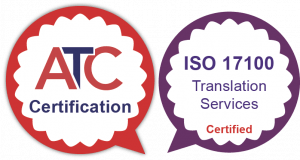Comms Multilingual regularly produces translations of training materials for our clients. Whether you are running a workshop that needs slide decks and handouts or booklets made available to speakers of other languages, or a fully-featured multimedia e-Learning course, we are able to help.
In addition to the translation side, Comms can handle materials in a wide variety of formats. For documents to be printed, we offer a full typesetting service, which means that you will receive the translations in their original file format, completely ready to use. We can also provide voice-overs with any type of voice, as specified by you, and subtitles.
Multilingual e-Learning Courses
There are many different aspects that need to be taken into consideration when looking to translate e-learning materials. It is very necessary not just to translate e-learning packages, but also to ensure that your materials have been carefully localised and adapted to the target market.
E-learning translation can cover many different types of learning materials. The main definition is that e-learning provides training and potentially testing materials in electronic format. One of the great advantages of this is that the person or people doing the training are not bound by a specific date, time, or even location. Additionally, it can be used for both collaborative and individual learning.
Within e-learning, you may just use plain text on screen, with participants able to follow this static text route through the training programme. On the other hand, it can be completely interactive experience, with contributions by and the ability to ask questions from a trainer in real time. Typically, e-learning materials will include some audiovisual and dynamic materials.
Translation, Localisation and Adaptation
We are not just talking about translating an e-Learning course: you will need to take into consideration any special colours, images or effects that are used. Certain colours have certain connotations in different countries. In China, for example, red is a very lucky colour and it represents happiness, beauty, success and good fortune.
You also need to be careful with the content of the e-learning courses sent for localisation. Admitting “I don’t know” is distasteful to an Arab so make sure that phrases such as this are not included in your materials. Also, constructive criticism can be taken as an insult to an Arabic speaker and so you must be very careful not to include any materials that could cause offence.
This is where our experience in localisation and adaptation is best leveraged, as we are able to discuss potential solutions in each language with our linguists.
Globalising e-Learning Materials
You should also avoid any mention to case studies or other references that are specific to the original target market. For example, any references to the NHS (UK National Health Service) wouldn’t be understood in other countries, so it may make sense to “globalise” e-Learning materials before translating them.
Creating e-Learning Materials for Translation
When creating your e-learning materials in programs such as Adobe Captivate, Articulate Storyline or another authoring tool, always bear in mind that translations into other languages may well take up more space than the original language. If your materials are constrained in terms of space, this will cause issues with some languages.
If you need an e-learning course voice-over, it is good to get some sample voices so that you can choose the most appropriate ones for your setting – we can provide samples for you. You will need to consider whether to have voice recordings or whether to go with subtitles.
Again, you will need to allow enough time when recording video or animating motion for someone in Spanish to be able to say their piece without having to rush through it. Typically, a translation into Spanish is quite a bit longer than an original English text. Multilingual subtitles are usually a précis of what is actually being said due to time and space constraints, so you will need to consider whether that will work for your materials or not.
If you have videos of people in your e-learning materials, you will need to consider the ethnic mix of the target country in order to ensure a true representation. Also, if you wish to offer Arabic, you might be advised not to include women in discussion with men.
Likewise, when translating e-Learning courses into right-to-left languages such as Arabic, you should ensure that the layout can be easily flipped to allow the translation to flow and function in the same way as the original.

Planning an e-Learning Translation Project
At Comms Multilingual, we are happy to provide you with advice in order to ensure that your e-learning materials can be successfully adapted for other markets. We like to work with you before you start putting together your e-learning materials, so that you can avoid any later issues when putting your e-learning into another language.
We can work with a number of e-learning authoring tools, including Articulate and Adobe Captivate. We also offer multilingual voice recording and subtitling capabilities.
Please contact us for a further discussion of your requirements.
What We Need from You
If you would like a quotation, please let us have the following information:
- With which authoring package was the course built?
- What documents will you send to us and in what format are they?
- In what format do you require the translated text?
- What services do you require?
- Exactly which text needs translating and which text needs other services?
- Is there any audio or video content? Will you need voice-over or subtitling for those parts?
- Into which languages would you like us to translate the text?
- Which are the target markets (i.e. countries in which the translated text will be used)?
- Are there any parts of the text that may need adapting and localising for the target countries? Would you like us to do that for you?
- When do you need the translated documents back?
- What are your expectations for development time before and after the translation phase?
Please get in touch with us using the form below so that we can analyse your needs and provide you with a quotation. If the files are large, please contact us for details of our secure FTP server or we can discuss other methods for transferring files.
